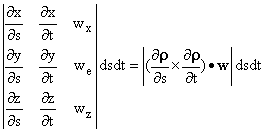| |
|||||
Given a surface S and vector field w, we have defined an integral, which is often called the flux of w through S. We defined it by dividing S into tiny locally planar pieces, and summing the product of the area of each piece multiplied by the component of w normal to it. This is the precise analogue of the ordinary one dimensional integral defined on an interval of the real line, with that interval replaced by our surface S. We denote it as
What then is the value of such an integral in terms of ordinary integrals? In the drawing, A and B represent As we saw in Chapter 3, this volume is the absolute value of the determinant
whose columns are the components of the three vectors
This is then the answer we seek. The surface integral here can be written as the double integral over the appropriate ranges of s and t of the explicit integrand written here. In the case of ordinary integrals, we assign the positive sign to area above the x axis, and negative sign to area below it. Here we also similarly associate sign to pieces of volume, so that the integrand we normally use is the actual determinant rather than its absolute value (given above) which represents signless volume. You will note that the sign of the expressions here is reversed on interchanging
s and t, which represents the fact that on an arbitrary piece of surface there
is no pre- defined answer to the question: which end is up? In whatever context
you are operating, I hope you know the answer to this question, and can arrange
the order of s and t here to agree with that answer.
up to the appropriate sign. Example:Suppose we have the surface defined by x = Rsin s cos t, y = Rsin s sin t,
z = Rcos s, for 0 < s < We find that the partials with respect to s here form the vector (Rcos s cos
t, R cos s sin t, -Rsin s) while those with respect to t form (-Rsin s sin t,
R sin s cos t, 0). We can evaluate the determinant by noticing that these partials
are normal to each other and to w, We also know, by the way, that the divergence of w is 0 except at the
origin. This tells us, by the divergence theorem, that if we modify our surface
by adding the surface of any region outside of the enclosed sphere to it, and
subtracting the surface area of any region inside it that does not include the
origin, we will not change this answer.
Exercise 24.1Express the integral over the vertical part of the outside of a vertical cylinder of radius r from z = 0 to 1 of wn with w = (x2, xy, z2) as a pair of ordinary integrals, that is, as a multiple integral. |
||||||||||||||||||||||||||

